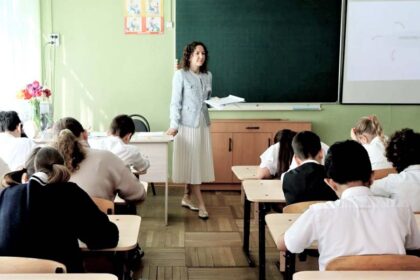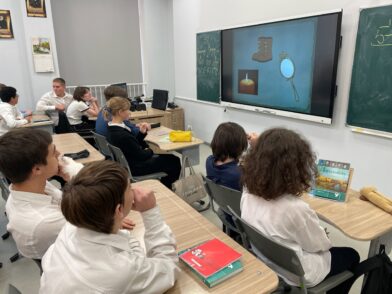Урок английского языка на тему «Реклама»
Полностью публикация приведена в формате PDF:Скачать/Просмотреть(Для просмотра необходима программа Adobe Reader или ее произвольный аналог).
Students’ book: Michael Harris, David Mower, Anna Sikorzynska, New Opportunities Intermediate (Russian Edition).
Objectives:
to introduce the types of advertising;
to enlarge the vocabulary;
to improve individual and group work skills.
Resources used:
a few examples of advertising from local newspapers and magazines, TV and radio adverts;
multimedia;
individual advertising cards.
Preparation for the lesson:
to lay out the examples of adverts from local newspapers and magazines;
to install multimedia;
to prepare additional working zones for creative group work (tables with 9 pictures on them, telephones, umbrellas, magnetic boards, magnets).
Stage 1 (Introduction)
Good morning, dear friends! How are you today? (Рupils’ answer). Are you ready to start? (Рupils’ answer). That’s great! I’d like to start our discussion with video. Look at the screen, please. Try to guess what we are going to do during this lesson. (Рresentation advertising video clip).
So do you catch the topic of our meeting? (Рupils’ answer). Ok! So now we are going to speak about advertising in brief.
Stage 2 (Discussion)
You know, the Canadian writer Marshal Mcluhan said «Advertising is the greatest art form of the 20th century». Is it really necessary to advertise goods or services? (Рupils’ answers, speaking on the question «Adverts. To be or not to be?», ex. 2, p. 57).
Exercise 2, page 57
Picture 1
And where can we find information about goods and services? (Рupils’ answer). Can you classify adverts into 4 different groups according to the place of publication? (Рupils’ answer) That’s great! So they are… (presentation of the slide).
Picture 2. The extract of the teacher’s presentation. «Sorts of advertising»
Dear friends! Try to analyze these four types and tell me what all these adverts have in common (Presentation of four different sorts of advertising: TV advert, radio advert, magazine advert and billboard advert).
Picture 3. Billboard advert
Picture 4. Magazine or newspaper adverts
Picture 5. TV advert
(Рupils’ answer to the question «Slogan»)
Slogan. That’s right. So we can say that one of the principle parts of any advert is Slogan. And what Slogans do you know? (Рupils’ answer)
I’ve prepared some more information for you. Let’s have a look at our screen. The most popular Slogans in the USA are… (Рresentation of the slide).
Picture 6. The extract of the teacher’s presentation. «The USA Slogans»
The most popular Slogans in Russia are… (Рresentation of the slide).
Picture 7. The extract of the teacher’s presentation. «Russian Slogans»
Do you know these brands? What are they? Let’s name them.
Dear friends! If we remember all the slides and adverts we can clearly understand that they all are different. And the way of promotion of the product depends on the audience the adverts are prepared for, on the product and of course on the policy of the company. So to understand it better I want you to look into your students’ books p. 57 and pick out the adjectives describing different adverts.
Key words: Opinion adjectives
amusing, attractive, awful, boring, brilliant, clever, colourful, dull, offensive, ridiculous, serious, sexist, shocking, silly, successful, tasteless, terrible, unusual, weird
(Vocabulary group/individual work – reading, pronunciation, translation of the words).
Individual cards:
Picture 8. Individual cards
Children take an advert prepared for them and try to describe it with the help of new words. For example: This is the advertising of one of the French mineral waters. It’s taken from a Russian magazine and it’s for different aged people. It’s made in the form of a cartoon to catch your eyes and to attract your attention. I think this advert is colourful, expressive and successful. Had I seen an ad like this I’d really like to buy this product.
Ok! Let’s continue describing adverts. Watch and tell me what your feelings and thoughts are? Is it a good way of promotion? (Presentation of two video clips, discussion).
So, now you are practically experts in advertising and because of that I want you to make up your own advert with the help of posters and a piece of written information. In 7 minutes we are checking your works but not in the usual form of reading your variant. I want you to be ready with acting out of the ad. You may use all the necessary things: telephone, umbrellas.
All the children are divided into groups of five. They are working in separate zones prepared for creative tasks. They are not sitting, they are standing. It helps to relax a little and to change the activity. It’s a kind of emotional and physical break in the middle of the lesson.
Group work:
Stage 1- preparation (children put the cards – continuity of the TV advert – in the correct order);
Stage 2 – presentation (children act out the conversation, if there is no wish to dramatize you may choose any other way you like);
Stage 3 – checking (children watch and compare their variant and the TV advert).
Before watching it the children are asked to think about advertising product. Girls and boys share their ideas and try to prove their point of view.
Stage 3 (Sum – up)
Dear friends! You know, not only professionals but also amateurs are good at producing adverts and you are the best example of it. I hope to watch your individual adverts in some days if it’s possible.
Жанна КУРЧЕНКОВА, учитель английского языка второй Новосибирской гимназии, лауреат конкурса
«Учитель года России-2007»
to install







 Выбор читателей
Выбор читателей






Комментарии